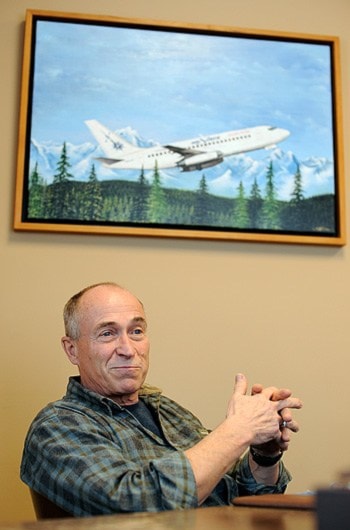A strange summer has ended at Whitehorse’s international airport.
“It’s all out of whack,” said Joseph Sparling, president of Air North.
Too many planes flew in and out of the airport during the summer, without enough people to fill seats.
At its peak, nine domestic flights left Whitehorse daily. Sparling estimates that almost 40 per cent of seats on these flights were empty.
By comparison, in 2011, flights operated by the top 10 carriers in North America were, on average, just over 80 per cent full, he said.
For the first time, Air North battled with two mainline carriers. From May to the end of October, WestJet flew from Whitehorse to Vancouver daily.
Air Canada had five daily flights; Air North ran three.
WestJet was pleased with how its route performed this summer, but has not decided whether it will return to Whitehorse next year, said spokesperson Robert Palmer in an email.
While consumers may like having more options, it can be costly for companies.
“It gives you lots of choices, but it really, in the long run, doesn’t benefit anybody,” said Sparling. “It all costs money, and at the end of the day, somebody has to pay for them.”
Despite that, Air North will set records in 2012 for passengers carried and revenues, said Sparling.
That’s partly thanks to the company adding new revenue sources. It now sells jet fuel to several customers, including Air Canada and WestJet. Air North employees also provide check-in service and load bags for American Airlines in Vancouver. In Whitehorse, they provide the same service for Condor Airlines.
[image2]
WestJet’s announcement early last year that it would begin servicing the territory didn’t come as a complete surprise to Sparling. And Air North had recently added more fuel-efficient aircraft to its fleet, which made it easier for the Yukon airline to compete.
But there’s still work to be done.
“I wouldn’t want to give the mistaken impression that everything’s great, having a new carrier in the market didn’t bother us - of course, it bothered us,” said Sparling.
While the company never “hit the panic button,” it “wasn’t unconcerned,” he said.
Air Canada and WestJet may be battling for seats in the North, but their real profits are in the south, said Sparling. They can handle losing money on north-south flights because these flights get passengers on money-making routes to cities like Toronto or Ottawa, he said.
“We’re kind of caught in the middle, and trying to avoid getting caught in the crossfires, is the way that I describe the dynamics a little bit,” he said.
“The battle is being fought up here, and the spoils of war are down south. We’ve gotta shift the battlelines south where it ought to be. And that’s kind of been the challenge for us.”
To do that, Air North needs to expand its reach, said Sparling.
That begins with some technology upgrades. Sparling says he’s “optimistic” that in about a month Air North will be part of the Sabre Global Distribution System. This will allow Air North flights to be sold on Expedia and Travelocity. The federal government also uses this system, he said.
“We have to take whatever steps we can to improve our access to the outside world and to people whose travel originates in the outside world.”
It also means continuing to work with Air Canada and WestJet. In the summer, the company struck an inter-line baggage agreement with Air Canada. That means passengers who transfer to Air Canada from an Air North flight only have to check their bags once.
Air North hopes to have a similar agreement in place with WestJet soon, said Sparling.
He also hopes Air North can strike code-share agreements with the mainline carriers, he said.
Under such agreements, a passenger purchases all the tickets for a multi-leg trip through one carrier. The latter parts of the trip are still marketed as being from that airline, even if the passenger is flying on planes run by other airlines.
More and more carriers are doing this, said Spalding.
“That’s probably going to be the optimum situation, and we haven’t found a way to move to that situation yet, but we’re going to keep trying.”
Contact Meagan Gillmore at
mgillmore@yukon-news.com
